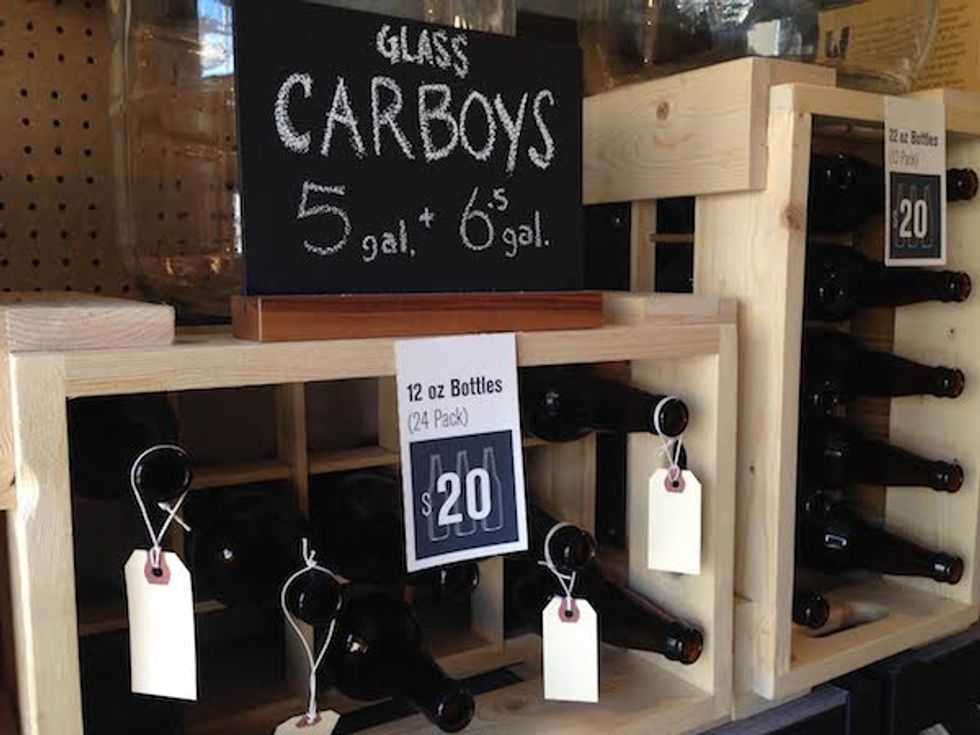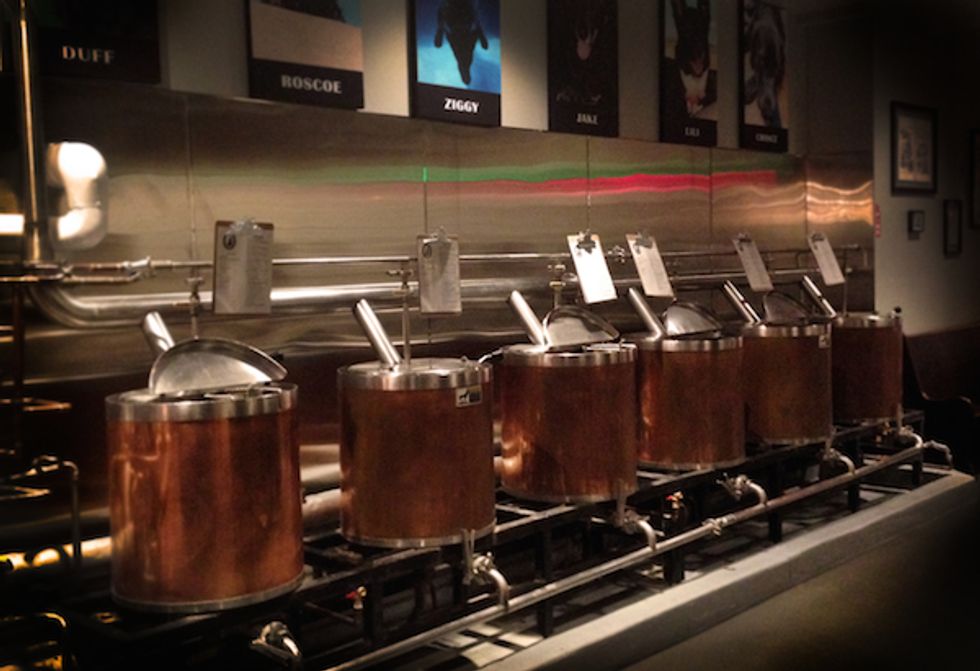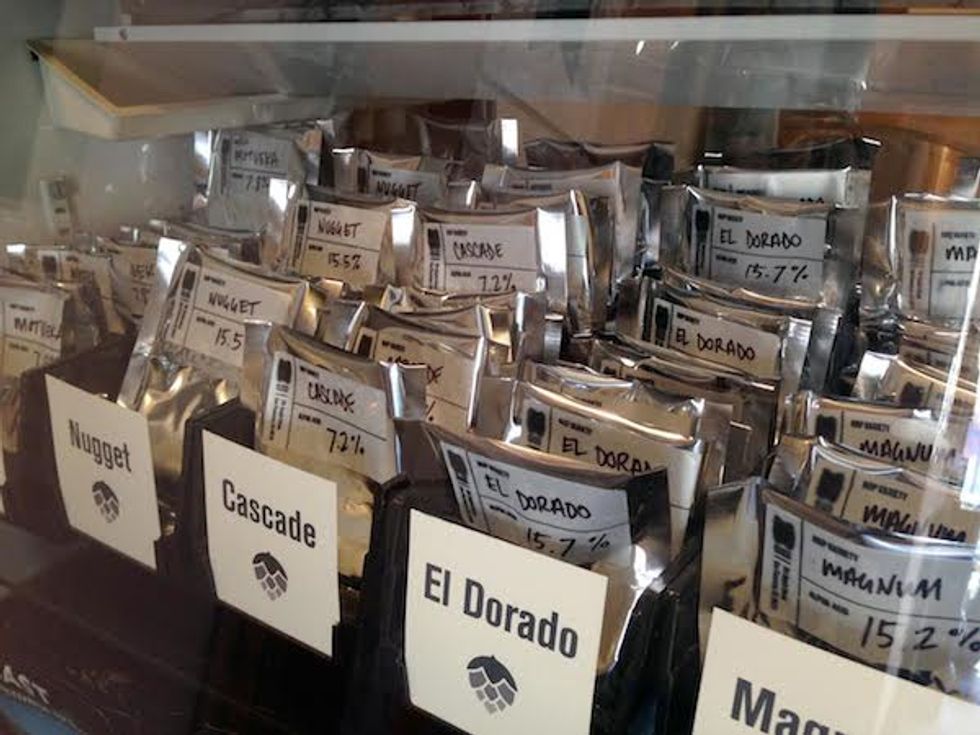Considering the major love affair between the Bay Area and craft beer, it's not surprising to see a proliferation of beer-centric stores, bars, and even new microbreweries popping up. But the best way to get involved in the Bay Area beer community, and indulge your DIY-spirit, is to homebrew. Anyone (yes, you!) can make beer, even in your tiny apartment kitchen.
Brewing is a relatively straightforward, step-by-step process, made even easier by two great additions to the Bay Area homebrew scene — Black Sands Beer in Lower Haight and Diving Dog Brewhouse in Uptown Oakland. Black Sands is currently open on Saturdays and Sundays, slinging homebrew tools, ingredients, and tips (with a full-on brewpub to come), while Diving Dog is a full brew-it-yourself facility, allowing you to brew batches using their top-quality equipment.
We checked in with Cole Emde and Andy Gilliland from Black Sands, and Rob Baillard of Diving Dog, to get their tips and tricks for becoming a master homebrewer.
Don't Let Space, or Cost, Intimidate You
"If you can make oatmeal, you can make beer," Emde says of the equipment needed for brewing. Well, you need a little more than your standard Ikea pot, but brewing equipment isn't all that complicated.
"The two largest pieces would be something to ferment in (clean bucket or glass carboy) and a good brew pot/kettle (6-8 gallons in volume) to boil in," Emde says. Other necessities? "You should have an airlock for the fermenter," Baillard adds. "Other items you should have are: hydrometer (for calculating the alcohol content), funnel (which makes transferring beer so much easier), grain sock (to easily remove spent grain from your wort), a hand operated pump for pumping out your beer (much like one would use to clean out a fish tank)."
Bottles and carboys at Black Sands.
"Hack" the Process With Items You Already Have
Before you buy, take a look around your kitchen — you may well have useful brewing gear already. "Homebrewing and brewing in general are great for this," Baillard says. "You can use an existing stove pot, and add a spigot on the bottom. You can use a colander to hold any grains during steeping. You can get a plastic bucket (food grade) with a top, screw in a hole for the airlock, and you have yourself a fermenter."
But, that initial buy-in doesn't have to be that bad. Homebrew stores (including Black Sands) often sell packaged "kits" with everything you need to make one to five gallon batches (at Black Sands, the former is $70, and the latter is $100-$200).
The Big Three: Cleanliness, Time, and Temperature
Clean, sanitized equipment is probably the most important part of any homebrew process, and an easy one to skimp on. Don't. "Always err on the side of extra cleaning," Baillard advises. His other big tip here: "Always remember to rinse after sanitizing, too, to get rid of any residue from sanitizers. You don't want that extra flavor in your beer!"
The timing, and temperature, of your brewing process can have a big impact on your beer's flavor, too, particularly during the fermentation period. Fortunately, San Francisco is the ideal spot for first-time brewers. "SF has almost perfect temperature ranges for most beers that you would make at home," Emde says. "Simply putting your beer in a dark closet for about two weeks is the perfect environment for healthy fermentation."
Kettles at Diving Dog
Brew The Kinds of Beer You Want to Drink
The best thing about homebrewing? You get to decide your approach based on what you like to drink. "On a commercial scale, you don't always brew exactly to your own tastes," Emde says. "When I'm brewing for me, I like to have the beers around that I want to drink."
That said, some beers are a little more complicated to brew than others. Baillard notes that wheat beers and dark beers are generally a little simpler. He loves (and brews) IPAs, even though they can be "kind of a pain" for filtration.
You can find ingredients for all kinds of beers (including a variety of hops, yeasts, and grains) in homebrew kits and at homebrew stores (you can get them measured and packaged for you, too). Black Sands and Diving Dog provide ingredients and recipes; you can find even more through the American Homebrewers Association and HomebrewForums.net.
Take Advantage of the Homebrew Community
There's a vibrant homebrew community in the Bay Area and beyond; once you get going, be sure to take advantage. "I've always found that advanced brewers are completely willing to share the knowledge that they have with you," Emde says. "Homebrewers are a really friendly group! If you ever attend a homebrew guild meeting, you'll see how much fun everyone is having with it, and how approachable and friendly everyone is."
This kind of knowledge sharing will be even more handy, and fun, as you start getting creative with your brewing. Once you figure out the basics... the sky's the limit. "Beer is so flexible that you can add just about anything to it," Baillard agrees. "You see that a lot in craft beer these days. I recently read about a brewer in Colorado who bought up all of the Count Chocula cereal in his area to brew with."
Assorted hops at Black Sands
Play the Name Game
Once you get brewing, you definitely need a name for your own upstart brewery. Black Sands is directly linked to the brewing process, and to the team's specific ideas around craft and creation. "Our name comes from the black sand inside of an hour glass, and it symbolizes time and patience," Emde explains. "Time and patience during fermentation is where all the magic happens. Without yeast and the process of fermentation we would have no beer at all!"
He notes that there's "no exact science" to coming up with a name, but clearly, keeping it personal to your own process is a win. Baillard agrees, suggesting that your name should be something that's both important to you personally, and relates to your love of beer.
"Diving Dog Brewhouse came from a picture I took of my childhood dog, Roscoe, while he was retrieving a ring from underwater," he says. "The picture was taken around the time I started homebrewing and fell in love with it, so, the two naturally went together in my mind."
Ready to start brewing? Check out Black Sands, Diving Dog, and the American Homebrewers Association for inspiration and tips.
























